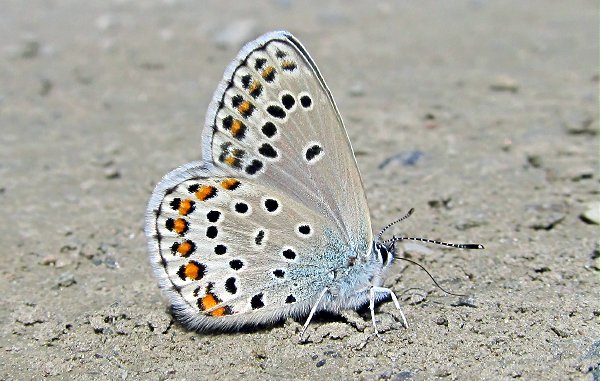Today's mission was to find
Satyrium hairstreaks in Valais - specifically
pruni and
acaceae. Despite just acceptable weather - hot, often overcast, sometimes raining but sometimes sunny - I didn't see any. Nevertheless it was a fascinating day, full of surprises!
The first surprise (after the pedal shank coming off my bike on the way down to Aigle) was this grayling,
Hipparchia semele:


Not great photos, if they'd been taken in a Suffolk wood in August, but quite special at 1200m in the Alps, on 4th June! My previous earliest date was 27th June (last year), right down in the valley - and I thought that was exceptional. This is an insect of late summer and autumn, which was flying in the valley well into November last year.
That alone would have made the trip worthwhile, but there was more to come. A large, dark blue flew past and I instinctively cried out '
Maculinea' (I haven't got used to '
Phengaris' yet) and followed it. It was a well worn male mountain alcon blue (
Phengaris rebeli), who must have been on the wing already in May, judging by his condition:


In the same stretch of meadow I quickly found another, this time in better nick:


I searched in vain for either the foodplant or a female, suggesting that the main site was some way away. My local colony of this species normally emerges at the very end of June or the beginning of July, but that is at 1500m rather than 1200m. There, the foodplant (
Gentiana cruciata) is common and easy to find and is usually covered in eggs during the flight season.
This is a lovely site. Amanda's blues were very common, with females now outnumbering the males in the main breeding area:


Many males were worn, having been on the wing two or three weeks now, but fresh ones were still emerging:

Amanda's blue (familiarly known as 'Mandy') is a large insect, almost as big as Iolas blue, and strikingly beautiful.
It really wasn't a day for photography, as it was mostly rather dark, but this scarce copper, my first of the year, was a true jewel in the grass and a delight to see:

Despite the lack of sun, many species were quite active, nectaring and posing. This is a black-veined white:

And here is a small skipper, caught against a grim background - rain was just about to fall.

And here he is in close-up, showing off the lovely red antennal tips that distinguish him (along with his crooked sex brand) from Essex skipper:

There was plenty else flying, but I'll close today's account with the brothers Sisyphus, engaging in what appears to be a rare cooperation against the odds! Normally these beetles fight over their dung balls but these two do seem to be working together. In his essay,
The Myth of Sisyphus, Camus saw joy, purpose and a sense of identity in the endless labour, concluding with the words, 'One must imagine Sisyphus happy'. We must imagine this pair happy!!
http://www.youtube.com/watch?v=YSYQ0RMeHNI[/video]
Guy
EDIT - I wonder if the dung beetles are a male and a female. This YouTube clip suggests that pairs of opposite sexes do work together:
http://www.youtube.com/watch?v=I1RHmSm36aE
























































